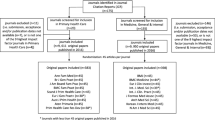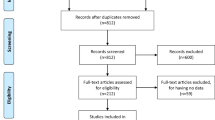Abstract
Scientific journals claim that correspondence sections are for post-publication peer review. We compared the conditions for submission and the bibliometrics of letters-to-editors published in leading medical journals in 2002 and 2007 using journal-derived information and data from PubMed and Journal Citation Reports. The median time limit for letter submissions decreased from 6 to 3.5 weeks, the median word limit from 400 to 350. The median number of letters per published article was near one in both years. Only about half of the letters were followed by an author reply in either year. Electronic response systems were available for four journals in 2007.
Similar content being viewed by others
References
Peers reviewed. Lancet, 1 (1989): 1115–1116.
Altman D. G., Poor-quality medical research: what can journals do? JAMA, 287 (2002) 2765–2767.
Altman D. G., Unjustified restrictions on letters to the editor. PLoS Med., 2 (2005) e126; discussion e152.
Bhopal R. S, Tonks A., The role of letters in reviewing research. BMJ, 308 (1994) 1582–1583.
Boyton R. J, Arnold P.C., An audit of the BMJ’s correspondence columns. BMJ, 301 (1990) 1419–1420.
Butler C., Old letters, new rules. Lancet, 361 (2003) 706.
Caswell A., Letters to the editor 1991. An audit of the MJA’s correspondence columns. Med. J. Aust., 157 (1992) 63–64.
Chew M., Villanueva E. V., van Der Weyden M. B., Life and times of the impact factor: retrospective analysis of trends for seven medical journals (1994–2005) and their Editors’ views. J. R. Soc. Med., 100 (2007) 142–150.
Committee on Publication Ethics (COPE). Code of conduct for editors of biomedical journals. Available at: http://publicationethics.org./code-conduct (2007).
Crossan L., Delamothe T., Letters to the editor: the new order. Please respond to articles using website, email, or disk-but not paper. BMJ, 316 (1998) 1406–1410.
Davies S., New edicts for letters to the editor — Be electronic, bold, and concise — no more than 300 words. BMJ, 326 (2003) 63–64.
Golubic R., Rudes M., Kovacic N., Marusic M., Marusic A., Calculating impact factor: how bibliographical classification of journal items affects the impact factor of large and small journals. Sci. Eng. Ethics., 14 (2008) 41–49.
Horton R., Postpublication criticism and the shaping of clinical knowledge. JAMA, 287 (2002) 2843–2847.
Mahesh S., Kabos M., Walvoort H. C., Overbeke A. J., Significance of letters published in the Dutch Journal of Medicine, 1997/98. Ned Tijdschr Geneeskd, 145 (2001) 531–535.
Maric C., Harris P. J., Alcorn D., Notice of retraction of article. Clin. Exp. Pharmacol. Physiol., 31 (2004) 657–658.
Maron N. L., Smith K. K., Current Models of Digital Scholarly Communication. Results of an Investigation Conducted by Ithaka for the Association of Research Libraries. Association of Research Libraries. Washington, DC, 2008. Available at: www.arl.org
Mullan Z., Lancet correspondence: old letters, new rules. Lancet, 361 (2003) 12.
Mullan Z., Letters or lectures? Lancet, 367 (2006) 1042.
O’connor P., Changes in renal medullary volume account for the relationship between arterial pressure and renal medullary interstitial cell lipid granule content. Clin. Exp. Pharmacol. Physiol., 31 (2004) 658; author reply 657.
Rennie D., Freedom and responsibility in medical publication: setting the balance right. JAMA, 280 (1998) 300–302.
Seglen P. O., Why the impact factor of journals should not be used for evaluating research. BMJ, 314 (1997) 498–502.
Stang A., Poole C., Schmidt-Pokrzywniak A., Pre-peer review, peer review, and post-peer review: Three areas with potential for improvement. J Clin Epidemiol, 61 (2008) 309–310.
World Association of Medical Editors (WAME). Policies on Letters to the Editor. March 2, 2007 to March 7, 2007. Available at: http://www.wame.org/wame-listserve-discussions/policies-on-letters-to-the-editor
World Association of Medical Editors (WAME). Case Consultation: Authors Do Not Respond to Critical Letters to the Editor. May 2003. Available at: http://www.wame.org/ethics-resources/. (2003).
Journal information
Annals of Internal Medicine. Philadelphia. American College of Physicians. ISSN: 0003-4819. Authors instructions available at: http://www.annals.org/shared/author_info.shtml#manuscriptpreparation
Annual Review of Medicine. Palo Alto. Annual Reviews. ISSN: 0066-4219. Authors instructions available at: http://arjournals.annualreviews.org/help?context=additionalInformation#Authors.
Archives of Internal Medicine. Chicago. American Medical Association. ISSN: 0003-9926. Author instructions available at: http://archinte.ama-assn.org/misc/authors.dtl.
BMJ: British Medical Journal. London. British Medical Association. ISSN: 0959-8146. Authors instructions available at: http://resources.bmj.com/bmj/authors.
CMAJ: Canadian Medical Association Journal. Ottawa. Canadian Medical Association. ISSN: 0820-3946. Authors instructions available at: http://www.cmaj.ca/authors/index.shtml.
JAMA: Journal of the American Medical Association. Chicago. American Medical Association. ISSN: 0002-9955. Authors instructions available at: http://jama.ama-assn.org/misc/authors.dtl.
Lancet. London. Lancet Publishing Group. ISSN: 0140-6736. Authors instructions available at: http://www.thelancet.com/authors/lancet/authorinfo
Medicine. Baltimore. Lippincott Williams Wilkins. ISSN: 0025-7974. Authors instructions available at: http://www.editorialmanager.com/md/.
New England Journal of Medicine. Boston, Massachusetts Medical Society. ISSN: 0028-4793. Author instructions available at: http://authors.nejm.org/Misc/LetterInstrx.asp.
Pediatrics. Elk Grove Village, IL. American Academy of Pediatrics. ISSN: 0031-4005. Author instructions available at: http://pediatrics.aappublications.org/.
PLoS Medicine. San Francisco. Public Library of Science. ISSN: 1549-1277. Authors instructions available at: http://journals.plos.org/plosmedicine/guidelines.php.
PLoS ONE. San Francisco. Public Library of Science. ISSN: 1932-6203 Author instructions available at: http://www.plosone.org/static/commentGuidelines.action.
Author information
Authors and Affiliations
Corresponding author
Rights and permissions
About this article
Cite this article
Von Elm, E., Wandel, S. & Jüni, P. The role of correspondence sections in post-publication peer review: A bibliometric study of general and internal medicine journals. Scientometrics 81, 747–755 (2009). https://doi.org/10.1007/s11192-009-2236-0
Received:
Published:
Issue Date:
DOI: https://doi.org/10.1007/s11192-009-2236-0




